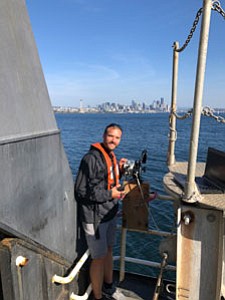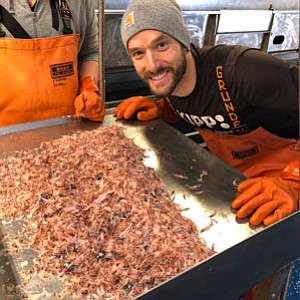Justin Garritt, a math teacher at KIPP Ujima Village Academy in Baltimore has returned from a journey that he believes will enhance his teaching experience and that of his students.
Garritt set sail to assist scientists on a 12-day Pacific Hake Survey in the Pacific Northwest where he participated as part of the National Oceanic and Atmospheric Administration’s (NOAA) Teacher at Sea program that bridges science and education through real-world research experiences.
“Through my two-week NOAA research cruise on the Pacific Ocean, my students will be able to learn first-hand about exciting projects being done to sustain our precious environment,” Garritt said of the journey that began on September 3, 2018. “Students will learn grade-level material by applying skills and concepts to real-life challenges from my trip. I am confident and excited that my student investment in my sixth grade statistics unit will be at an all-time high.”
Garritt boarded NOAA Ship Bell M. Shimada in Seattle, Washington, and worked with scientists daily as they conducted an ongoing survey of Pacific Hake populations off the coast of Washington and Oregon. He also wrote a blog detailing his experience.
“Our students spend a significantly longer portion of their school year in math compared to science. Many of our world’s most important problems require amazing and informed scientists and our kids have to be a part of those solutions,” Garritt said. “As a mathematics teacher who has the privilege of having my students for double the time of our science team, it is crucial that I make cross-curricular connections to science in my classroom. As a lifelong learner, being aboard a NOAA ship allowed me the chance to investigate new and creative ways to infuse all the research I will be doing into my curriculum.”
Now in its 28th year, the Teacher at Sea program has provided nearly 750 teachers the opportunity to gain first-hand experience participating in science at sea, according to a news release.
This year, NOAA received applications from nearly 300 teachers and 35 were chosen to participate in research cruises. The educators live and work side-by-side with scientists studying the marine environment.
NOAA’s mission is to understand and predict changes in the Earth’s environment, from the depths of the ocean to the surface of the sun, and to conserve and manage coastal and marine resources, officials said.
Courtesy Photo
Justin Garritt calibrating the research equipment in the Port of Seattle aboard NOAA Bell A. Shimada.
“This experience was one of the best of my professional career. I felt so intellectually stimulated learning about something I knew so little about,” Garritt said.
“I felt like I went back to college and starting over learning a brand new subject. For twelve hours a day I was learning, reflecting, and writing my blog.”
Throughout the experience, Garritt said he learned how to use the acoustic transducers that analyze the fish patterns below the surface. He also learned the process for surveying the Pacific hake population and how scientists collect data and analyze it.
Further, Garritt learned how the NOAA makes decision on the number of fish that commercial fisherman are allowed to catch; how dissect hake; what life is like for the crew aboard the vessels; and what life was like for scientists who spend their lives working to protect natural resources.
“After two weeks learning on the research cruise I decided to begin rewriting many of my statistics lessons from the city’s math curriculum, Eureka Math, so they involve the same standards and types of rigorous questions but involve the application of the data from my experience,” Garritt said.
Courtesy Photo
Justin Garritt analyzing a pile of krill that was caught outside of the Port of Newport
“This will not only blend math and science knowledge, but will increase student investment. I can’t wait for students at my school to see me working among the most talented scientists in the world doing real life important science work.
“I can’t wait for them to picture themselves someday working as scientists with NOAA and solving our world’s most important problems that involve our precious environment. I can’t wait for my students to get excited when learning statistics, scaling and ratios— actual data I collected while sailing in the Pacific Northwest.”
Garritt’s blog about the program can be viewed at https://noaateacheratsea.blog/author/jgarritt2018


